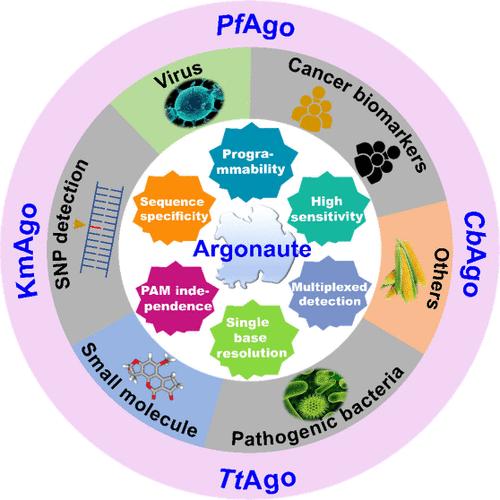Argonaute-Based Nucleic Acid Detection Technology: Advantages, Current Status, Challenges, and Perspectives
IF 9.1
1区 化学
Q1 CHEMISTRY, ANALYTICAL
引用次数: 0
Abstract
Rapid and accurate detection is a prerequisite for precise clinical diagnostics, ensuring food safety, and facilitating biotechnological applications. The Argonaute system, as a cutting-edge technique, has been successfully repurposed in biosensing beyond the CRISPR/Cas system (clustered regularly interspaced short palindromic repeats and CRISPR-associated proteins), which has been extensively researched, but recognition of PAM sequences remains restricted. Argonaute, as a programmable and target-activated nuclease, is repurposed for fabricating novel detection methods due to its unparalleled biological features. In this comprehensive review, we initially elaborate on the current methods for nucleic acid testing and programmable nucleases, followed by delving into the structure and nuclease activity of the Argonaute system. The advantages of Argonaute compared with the CRISPR/Cas system in nucleic acid detection are highlighted and discussed. Furthermore, we summarize the applications of Argonaute-based nucleic acid detection and provide an in-depth analysis of future perspectives and challenges. Recent research has demonstrated that Argonaute-based biosensing is an innovative and rapidly advancing technology that can overcome the limitations of existing methods and potentially replace them. In summary, the implementation of Argonaute and its integration with other technologies hold promise in developing customized and intelligent detection methods for nucleic acid testing across various aspects.

基于 Argonaute 的核酸检测技术:优势、现状、挑战和前景
快速准确的检测是精确临床诊断、确保食品安全和促进生物技术应用的先决条件。Argonaute 系统作为一种前沿技术,已成功地重新用于 CRISPR/Cas 系统(簇状规则间隔短回文重复序列和 CRISPR 相关蛋白)之外的生物传感领域,该系统已得到广泛研究,但对 PAM 序列的识别仍受到限制。Argonaute 作为一种可编程的靶激活核酸酶,因其无与伦比的生物学特性而被重新用于制造新型检测方法。在这篇综述中,我们首先阐述了当前的核酸检测方法和可编程核酸酶,然后深入探讨了 Argonaute 系统的结构和核酸酶活性。我们强调并讨论了 Argonaute 与 CRISPR/Cas 系统相比在核酸检测方面的优势。此外,我们还总结了基于 Argonaute 的核酸检测的应用,并深入分析了未来的前景和挑战。最新研究表明,基于 Argonaute 的生物传感技术是一项创新且发展迅速的技术,可以克服现有方法的局限性,并有可能取代现有方法。总之,Argonaute 的实施及其与其他技术的整合有望为核酸检测的各个方面开发出定制的智能检测方法。
本文章由计算机程序翻译,如有差异,请以英文原文为准。
求助全文
约1分钟内获得全文
求助全文
来源期刊

ACS Sensors
Chemical Engineering-Bioengineering
CiteScore
14.50
自引率
3.40%
发文量
372
期刊介绍:
ACS Sensors is a peer-reviewed research journal that focuses on the dissemination of new and original knowledge in the field of sensor science, particularly those that selectively sense chemical or biological species or processes. The journal covers a broad range of topics, including but not limited to biosensors, chemical sensors, gas sensors, intracellular sensors, single molecule sensors, cell chips, and microfluidic devices. It aims to publish articles that address conceptual advances in sensing technology applicable to various types of analytes or application papers that report on the use of existing sensing concepts in new ways or for new analytes.
 求助内容:
求助内容: 应助结果提醒方式:
应助结果提醒方式:


